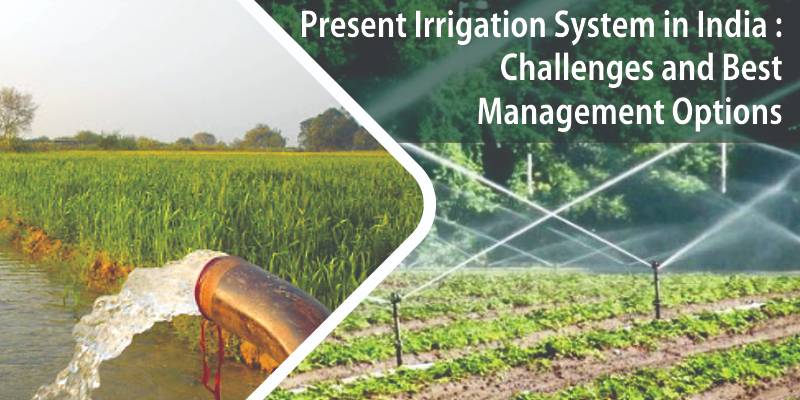Agriculture, which gives 54.6% of employment to the developing Indian populace, alone uses over 90% of absolute groundwater draft in irrigation.
Groundwater has become the predominant source of irrigation because of its autonomous access and opportune accessibility of water.
This ludicrous reliance on groundwater has prompted depletion of the water table.
India has a populace as much as 15% of the total world population yet has just about 4% of the world’s freshwater assets.
The normal yearly precipitation in the nation is around 1,170 mm including snowfall.
As agriculture alone uses about 80% of the absolute withdrawal of water, so water management in agriculture becomes essential for food security.
Supply-side administration rehearses incorporate watershed improvement and water asset advancement through major, medium, and minor irrigation activities; and advancement of drainage framework to keep away from salinity and waterlogging issues.
Different Irrigation Systems in India
- Drip Irrigation
- Sprinkler Irrigation
- Well and Tube Well Irrigation
- Canal Irrigation
- Tank Irrigation
- Furrow Irrigation
Challenges for Irrigation in India
Depletion of Groundwater Table
States, which the most elevated reliance on groundwater Irrigation are Punjab (79%), Uttar Pradesh (80%), and Uttarakhand (67%). According to the appraisal completed by the Central Ground Water Board (CGWB) in 2013, India’s absolute yearly replenishable groundwater asset is around 433 billion cubic meters (BCM) and net yearly groundwater accessibility is 398 BCM of which India pulls out 253 BCM (62%) every year. As per the CGWB, around 39% of the wells are showing a decrease in groundwater level.
Uneven Distribution of Rainfall
In India, about almost 50% of the net planted region goes under rainfed lands. Even in the wake of accomplishing extreme irrigation potential, 31% of cultivable regions will stay under rainfed development.
There has been extensive spatial and transient variety in precipitation in India.
The greater part of the precipitation happens with the beginning of the southwest storm during June to October month.
It shifts from under 100 mm in western Rajasthan to more than 2500mm in the upper east area of the nation.
Poor Irrigation Efficiency
In general, normal irrigation productivity is seen as 38%, which is much underneath wanted effectiveness. Normal transport effectiveness is 70%. Along these lines, there is a degree to lessen misfortunes happening because of poor irrigation foundations like unlined waterways and channels.
Water spillage is breaks, dissolved mortar, and primary disappointment of lined dividers. There is a deficient and unpredictable channel water supply in many order regions.
Further, commonly channels have breaks, which cause relocation of thousands of individuals, obliteration of properties, land, and harm to expensive yields worth millions of Rupees.
Huge Gap in Irrigation Potential
All out the use of irrigation potential was to the degree of 87.86 million hectares as against the complete made capability of 113.53 million hectares showing a gap of 25.67 million hectares.
The fundamental reason for this non-use of made potential is a delay in on-farm works like the development of field channels, land development, and leveling.
Regular Dry Spells and Groundwater Abuse
The recurrence of the event of dry spell years has essentially expanded in India. In India, the absence of rain brings about water deficiencies, coming about in less than ideal harvest yields.
This especially happens in a significant dry season over 60% space of the country.
Nonetheless, the subsequent groundwater abuse and quality weakening mean there is likewise less groundwater accessible for farming than there was previously, in this manner causing much more tension on rural area.
Water Management Option
Infrastructural Improvement for Satisfactory and Standard Water Supply
There is a deficient and unpredictable trench water supply in numerous orders. To handle this conjunctive water use should be worked with. Further, the formation of proper foundations is needed to enhance canal water and groundwater.
Drainage System Improvement
The issue of waterlogging and salinity requires conjunctive water use with drip and sprinkler irrigation. With the help of the drainage system, these problems may get reduce.
Improving Micro Irrigation System
The conventional techniques for water systems have low water system proficiency because of over-the-top leakage misfortune, discrimination, and less-than-ideal supplies. Micro-irrigation can assume an indispensable part in progress in water use proficiency.
Use of sprinkler and drip water system any place appropriate improves irrigation productivity.
Correlation of different techniques for Irrigation recommends that drip water system accomplishes most noteworthy application productivity of 90% with by and large proficiency going between 80-90 percent.
Ideal Crop Plans
Because of the differing water necessity of each crop, groundwater misuse might be decreased groundwater. proper crop planning may help in reducing the water table depletion problem in India.
Appropriate Use of Water
Indian farmers utilize 2-4 times more water to create a unit of grain when contrasted with China and Brazil.
There is a need to educate farmers in India on how to use water for irrigation appropriately.
Rapid exhaustion of water table, low water system productivity, and incessant dry spells demonstrate towards water emergency in future if existing water use design isn’t corrected.
The irrigation framework should be additionally improved to harvest rainwater. Micro-irrigation system has scope for improving water system produces up to 90 percent.
By clicking on our website you will get more options to check.
Visit our page for more information about Tractor, Agricultural implements, Tractor Price, Tractor Videos, and Tractor Games.




